Design Thinking and Innovation at Apple Inc. Case Study
VerifiedAdded on 2022/10/12
|19
|4974
|143
Case Study
AI Summary
This case study analyzes Apple Inc.'s design thinking and innovation processes from 1997 to 2012, examining its evolution, strengths, and weaknesses. The report conducts SWOT and PESTLE analyses, and uses the Palmer and Kaplan and Double Diamond models to evaluate Apple's innovation. It explores the influence of Steve Jobs, identifies risks and limitations, and formulates hypotheses. The analysis includes recommendations for improvement, focusing on training, customer orientation, and leadership. The study aims to understand Apple's innovative approach and its ability to maintain a competitive advantage in the technology market. The report provides a comprehensive overview of Apple's design thinking, innovation, and its evolution over time.
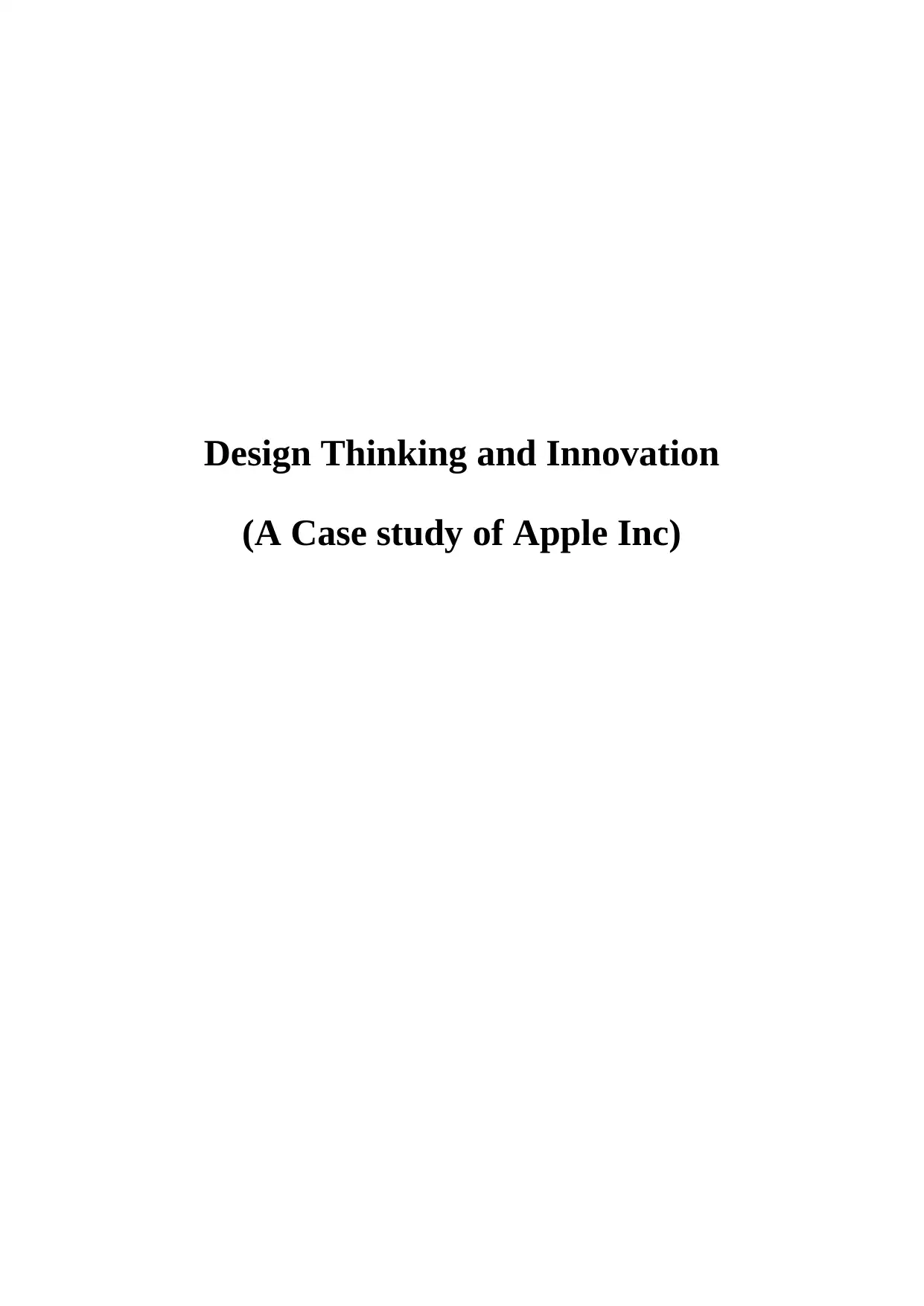
Design Thinking and Innovation
(A Case study of Apple Inc)
(A Case study of Apple Inc)
Paraphrase This Document
Need a fresh take? Get an instant paraphrase of this document with our AI Paraphraser
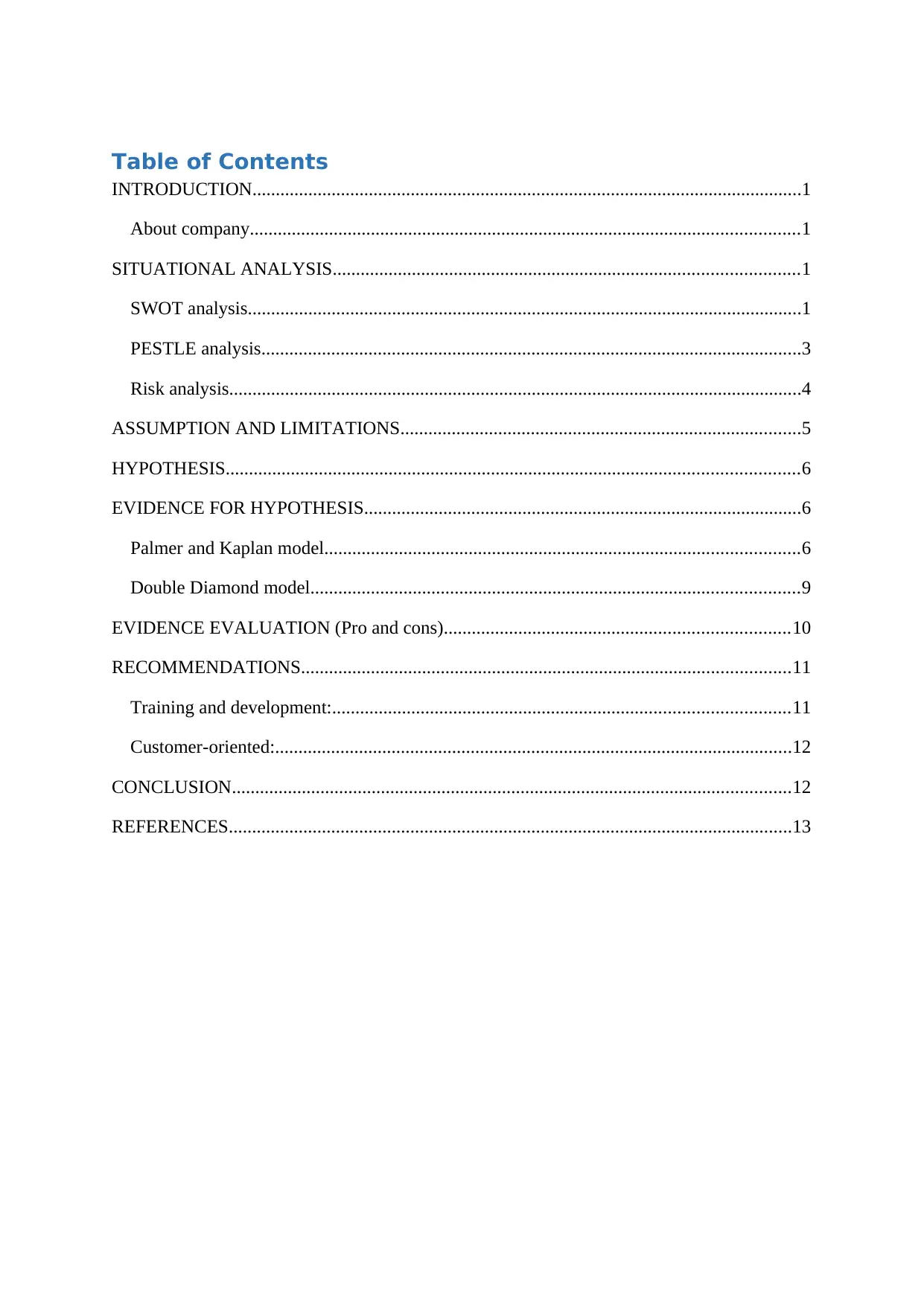
Table of Contents
INTRODUCTION......................................................................................................................1
About company......................................................................................................................1
SITUATIONAL ANALYSIS....................................................................................................1
SWOT analysis.......................................................................................................................1
PESTLE analysis....................................................................................................................3
Risk analysis...........................................................................................................................4
ASSUMPTION AND LIMITATIONS......................................................................................5
HYPOTHESIS...........................................................................................................................6
EVIDENCE FOR HYPOTHESIS..............................................................................................6
Palmer and Kaplan model......................................................................................................6
Double Diamond model.........................................................................................................9
EVIDENCE EVALUATION (Pro and cons)..........................................................................10
RECOMMENDATIONS.........................................................................................................11
Training and development:..................................................................................................11
Customer-oriented:...............................................................................................................12
CONCLUSION........................................................................................................................12
REFERENCES.........................................................................................................................13
INTRODUCTION......................................................................................................................1
About company......................................................................................................................1
SITUATIONAL ANALYSIS....................................................................................................1
SWOT analysis.......................................................................................................................1
PESTLE analysis....................................................................................................................3
Risk analysis...........................................................................................................................4
ASSUMPTION AND LIMITATIONS......................................................................................5
HYPOTHESIS...........................................................................................................................6
EVIDENCE FOR HYPOTHESIS..............................................................................................6
Palmer and Kaplan model......................................................................................................6
Double Diamond model.........................................................................................................9
EVIDENCE EVALUATION (Pro and cons)..........................................................................10
RECOMMENDATIONS.........................................................................................................11
Training and development:..................................................................................................11
Customer-oriented:...............................................................................................................12
CONCLUSION........................................................................................................................12
REFERENCES.........................................................................................................................13

List of figures
Figure 1: Palmer and Kaplan model...........................................................................................7
Figure 2: Double Diamond model..............................................................................................9
Figure 1: Palmer and Kaplan model...........................................................................................7
Figure 2: Double Diamond model..............................................................................................9
⊘ This is a preview!⊘
Do you want full access?
Subscribe today to unlock all pages.

Trusted by 1+ million students worldwide

List of tables
Table 1: SWOT analysis 1997...................................................................................................1
Table 2: SWOT analysis 2012...................................................................................................2
Table 1: SWOT analysis 1997...................................................................................................1
Table 2: SWOT analysis 2012...................................................................................................2
Paraphrase This Document
Need a fresh take? Get an instant paraphrase of this document with our AI Paraphraser
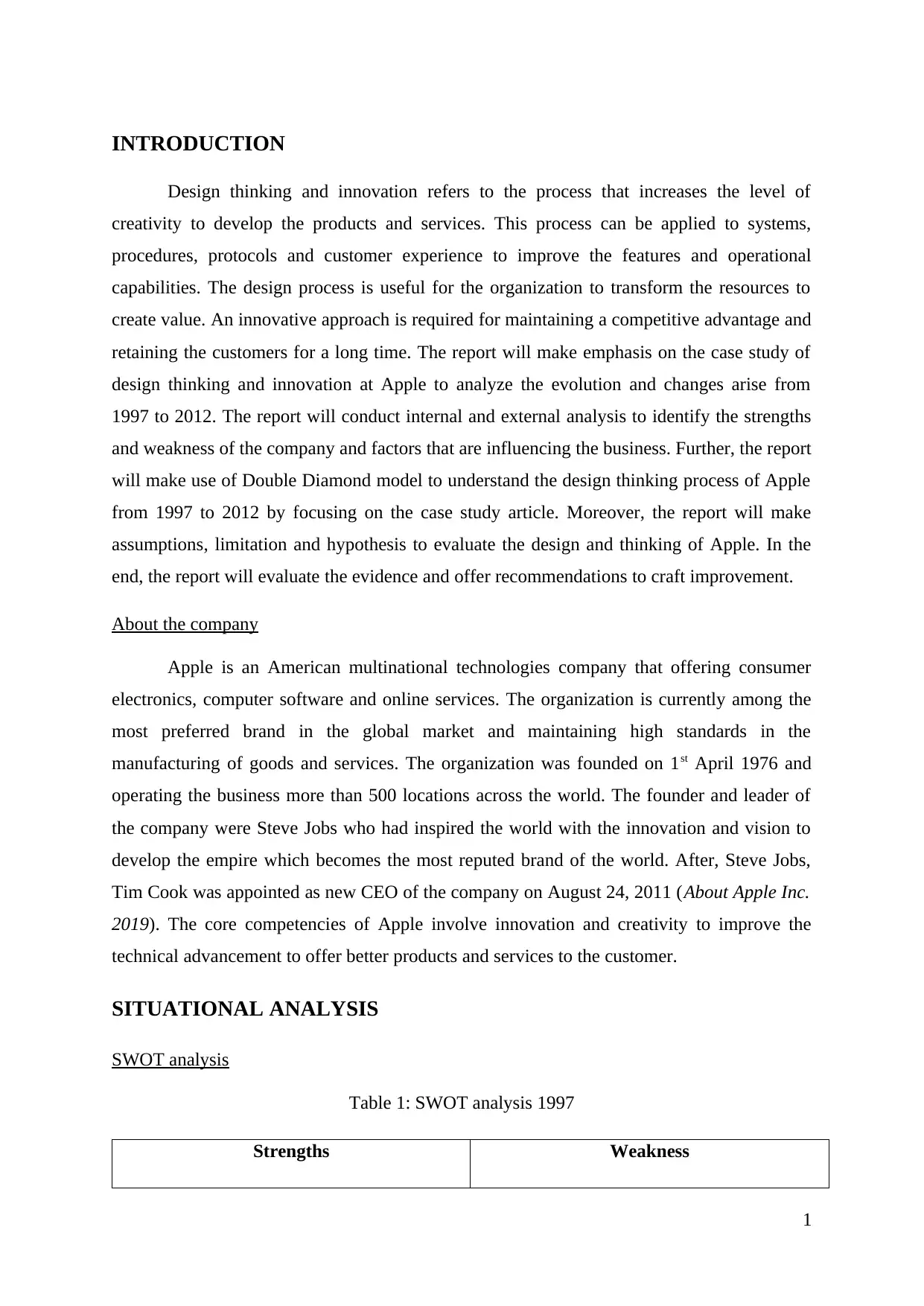
INTRODUCTION
Design thinking and innovation refers to the process that increases the level of
creativity to develop the products and services. This process can be applied to systems,
procedures, protocols and customer experience to improve the features and operational
capabilities. The design process is useful for the organization to transform the resources to
create value. An innovative approach is required for maintaining a competitive advantage and
retaining the customers for a long time. The report will make emphasis on the case study of
design thinking and innovation at Apple to analyze the evolution and changes arise from
1997 to 2012. The report will conduct internal and external analysis to identify the strengths
and weakness of the company and factors that are influencing the business. Further, the report
will make use of Double Diamond model to understand the design thinking process of Apple
from 1997 to 2012 by focusing on the case study article. Moreover, the report will make
assumptions, limitation and hypothesis to evaluate the design and thinking of Apple. In the
end, the report will evaluate the evidence and offer recommendations to craft improvement.
About the company
Apple is an American multinational technologies company that offering consumer
electronics, computer software and online services. The organization is currently among the
most preferred brand in the global market and maintaining high standards in the
manufacturing of goods and services. The organization was founded on 1st April 1976 and
operating the business more than 500 locations across the world. The founder and leader of
the company were Steve Jobs who had inspired the world with the innovation and vision to
develop the empire which becomes the most reputed brand of the world. After, Steve Jobs,
Tim Cook was appointed as new CEO of the company on August 24, 2011 (About Apple Inc.
2019). The core competencies of Apple involve innovation and creativity to improve the
technical advancement to offer better products and services to the customer.
SITUATIONAL ANALYSIS
SWOT analysis
Table 1: SWOT analysis 1997
Strengths Weakness
1
Design thinking and innovation refers to the process that increases the level of
creativity to develop the products and services. This process can be applied to systems,
procedures, protocols and customer experience to improve the features and operational
capabilities. The design process is useful for the organization to transform the resources to
create value. An innovative approach is required for maintaining a competitive advantage and
retaining the customers for a long time. The report will make emphasis on the case study of
design thinking and innovation at Apple to analyze the evolution and changes arise from
1997 to 2012. The report will conduct internal and external analysis to identify the strengths
and weakness of the company and factors that are influencing the business. Further, the report
will make use of Double Diamond model to understand the design thinking process of Apple
from 1997 to 2012 by focusing on the case study article. Moreover, the report will make
assumptions, limitation and hypothesis to evaluate the design and thinking of Apple. In the
end, the report will evaluate the evidence and offer recommendations to craft improvement.
About the company
Apple is an American multinational technologies company that offering consumer
electronics, computer software and online services. The organization is currently among the
most preferred brand in the global market and maintaining high standards in the
manufacturing of goods and services. The organization was founded on 1st April 1976 and
operating the business more than 500 locations across the world. The founder and leader of
the company were Steve Jobs who had inspired the world with the innovation and vision to
develop the empire which becomes the most reputed brand of the world. After, Steve Jobs,
Tim Cook was appointed as new CEO of the company on August 24, 2011 (About Apple Inc.
2019). The core competencies of Apple involve innovation and creativity to improve the
technical advancement to offer better products and services to the customer.
SITUATIONAL ANALYSIS
SWOT analysis
Table 1: SWOT analysis 1997
Strengths Weakness
1
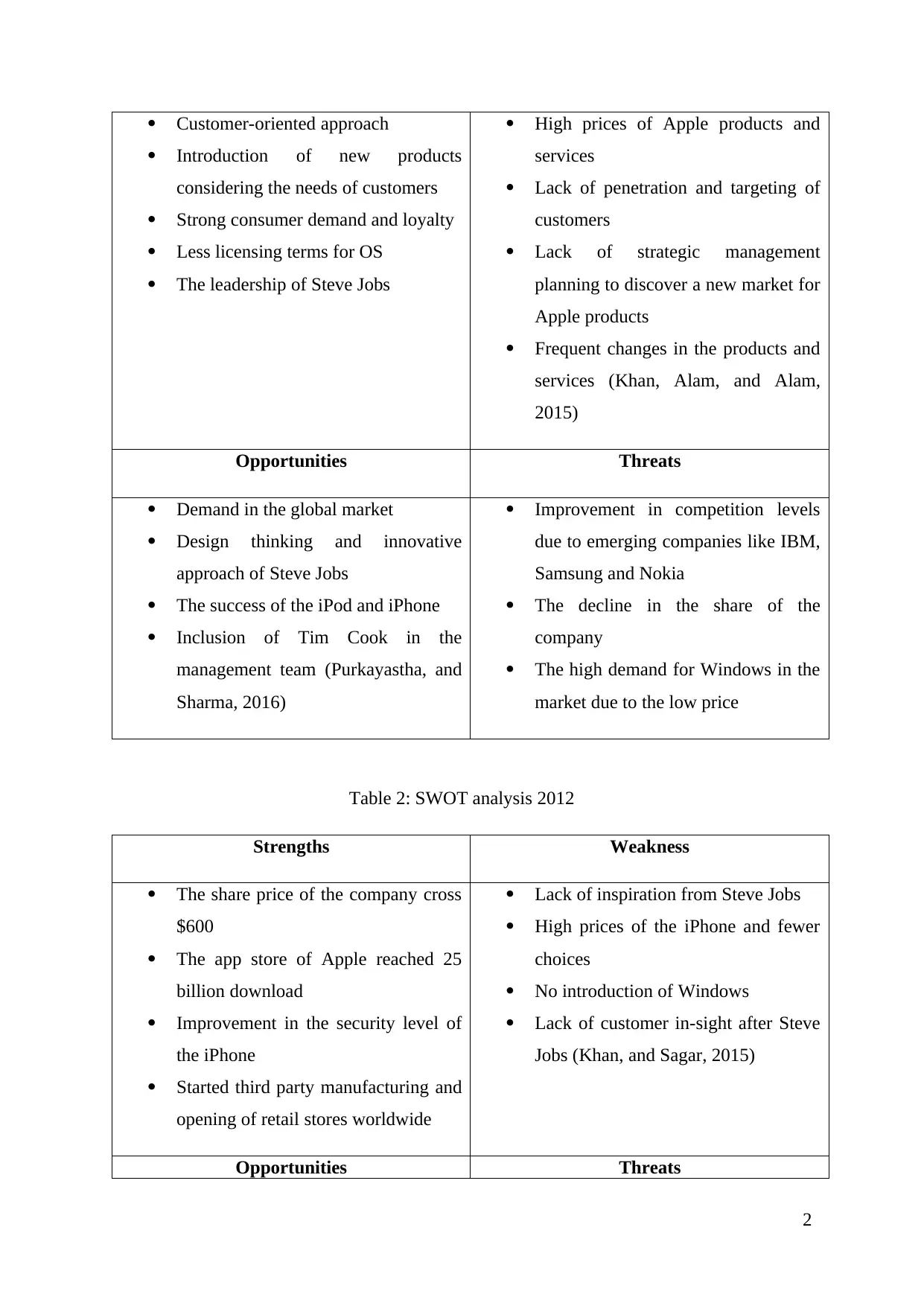
Customer-oriented approach
Introduction of new products
considering the needs of customers
Strong consumer demand and loyalty
Less licensing terms for OS
The leadership of Steve Jobs
High prices of Apple products and
services
Lack of penetration and targeting of
customers
Lack of strategic management
planning to discover a new market for
Apple products
Frequent changes in the products and
services (Khan, Alam, and Alam,
2015)
Opportunities Threats
Demand in the global market
Design thinking and innovative
approach of Steve Jobs
The success of the iPod and iPhone
Inclusion of Tim Cook in the
management team (Purkayastha, and
Sharma, 2016)
Improvement in competition levels
due to emerging companies like IBM,
Samsung and Nokia
The decline in the share of the
company
The high demand for Windows in the
market due to the low price
Table 2: SWOT analysis 2012
Strengths Weakness
The share price of the company cross
$600
The app store of Apple reached 25
billion download
Improvement in the security level of
the iPhone
Started third party manufacturing and
opening of retail stores worldwide
Lack of inspiration from Steve Jobs
High prices of the iPhone and fewer
choices
No introduction of Windows
Lack of customer in-sight after Steve
Jobs (Khan, and Sagar, 2015)
Opportunities Threats
2
Introduction of new products
considering the needs of customers
Strong consumer demand and loyalty
Less licensing terms for OS
The leadership of Steve Jobs
High prices of Apple products and
services
Lack of penetration and targeting of
customers
Lack of strategic management
planning to discover a new market for
Apple products
Frequent changes in the products and
services (Khan, Alam, and Alam,
2015)
Opportunities Threats
Demand in the global market
Design thinking and innovative
approach of Steve Jobs
The success of the iPod and iPhone
Inclusion of Tim Cook in the
management team (Purkayastha, and
Sharma, 2016)
Improvement in competition levels
due to emerging companies like IBM,
Samsung and Nokia
The decline in the share of the
company
The high demand for Windows in the
market due to the low price
Table 2: SWOT analysis 2012
Strengths Weakness
The share price of the company cross
$600
The app store of Apple reached 25
billion download
Improvement in the security level of
the iPhone
Started third party manufacturing and
opening of retail stores worldwide
Lack of inspiration from Steve Jobs
High prices of the iPhone and fewer
choices
No introduction of Windows
Lack of customer in-sight after Steve
Jobs (Khan, and Sagar, 2015)
Opportunities Threats
2
⊘ This is a preview!⊘
Do you want full access?
Subscribe today to unlock all pages.

Trusted by 1+ million students worldwide
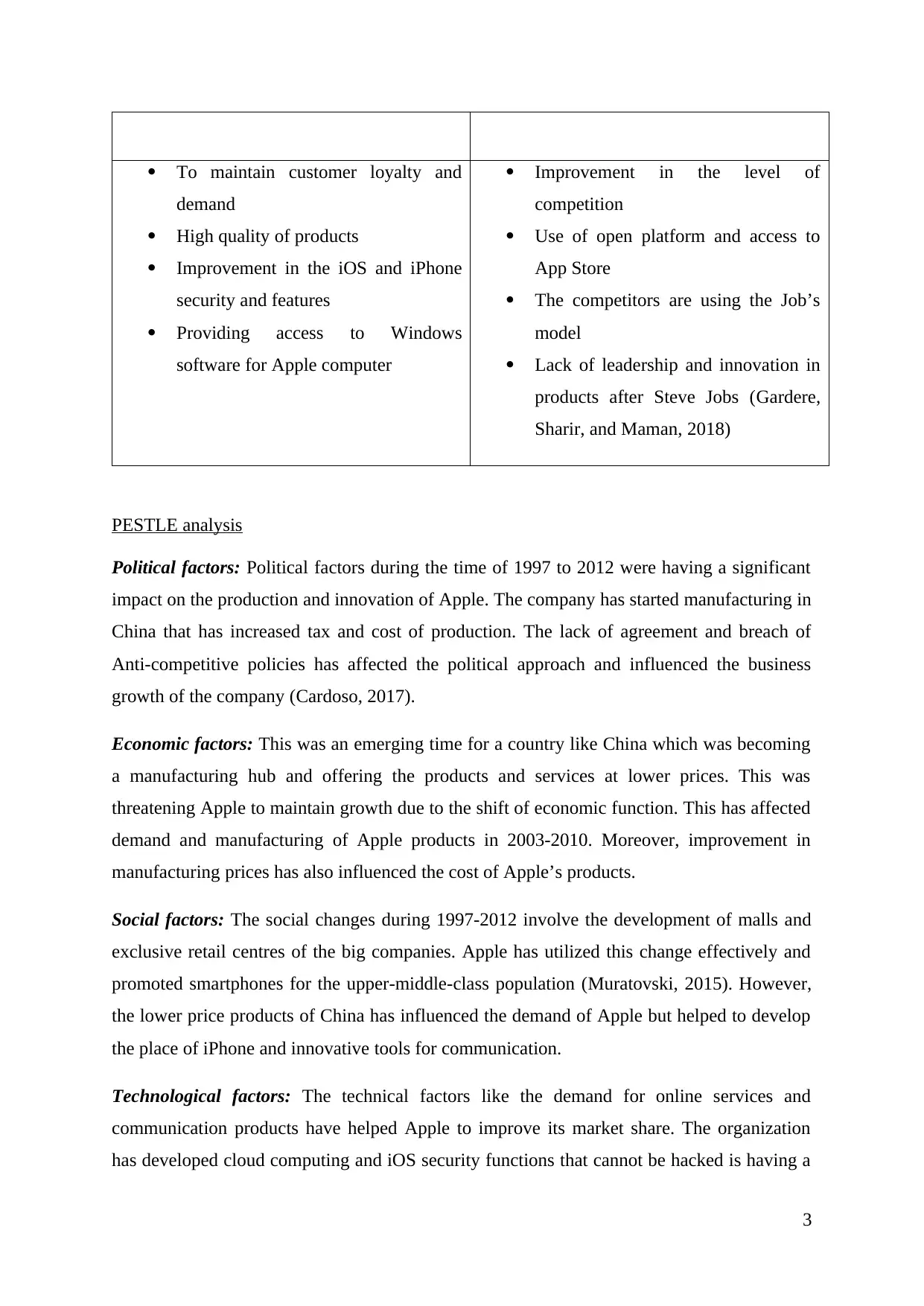
To maintain customer loyalty and
demand
High quality of products
Improvement in the iOS and iPhone
security and features
Providing access to Windows
software for Apple computer
Improvement in the level of
competition
Use of open platform and access to
App Store
The competitors are using the Job’s
model
Lack of leadership and innovation in
products after Steve Jobs (Gardere,
Sharir, and Maman, 2018)
PESTLE analysis
Political factors: Political factors during the time of 1997 to 2012 were having a significant
impact on the production and innovation of Apple. The company has started manufacturing in
China that has increased tax and cost of production. The lack of agreement and breach of
Anti-competitive policies has affected the political approach and influenced the business
growth of the company (Cardoso, 2017).
Economic factors: This was an emerging time for a country like China which was becoming
a manufacturing hub and offering the products and services at lower prices. This was
threatening Apple to maintain growth due to the shift of economic function. This has affected
demand and manufacturing of Apple products in 2003-2010. Moreover, improvement in
manufacturing prices has also influenced the cost of Apple’s products.
Social factors: The social changes during 1997-2012 involve the development of malls and
exclusive retail centres of the big companies. Apple has utilized this change effectively and
promoted smartphones for the upper-middle-class population (Muratovski, 2015). However,
the lower price products of China has influenced the demand of Apple but helped to develop
the place of iPhone and innovative tools for communication.
Technological factors: The technical factors like the demand for online services and
communication products have helped Apple to improve its market share. The organization
has developed cloud computing and iOS security functions that cannot be hacked is having a
3
demand
High quality of products
Improvement in the iOS and iPhone
security and features
Providing access to Windows
software for Apple computer
Improvement in the level of
competition
Use of open platform and access to
App Store
The competitors are using the Job’s
model
Lack of leadership and innovation in
products after Steve Jobs (Gardere,
Sharir, and Maman, 2018)
PESTLE analysis
Political factors: Political factors during the time of 1997 to 2012 were having a significant
impact on the production and innovation of Apple. The company has started manufacturing in
China that has increased tax and cost of production. The lack of agreement and breach of
Anti-competitive policies has affected the political approach and influenced the business
growth of the company (Cardoso, 2017).
Economic factors: This was an emerging time for a country like China which was becoming
a manufacturing hub and offering the products and services at lower prices. This was
threatening Apple to maintain growth due to the shift of economic function. This has affected
demand and manufacturing of Apple products in 2003-2010. Moreover, improvement in
manufacturing prices has also influenced the cost of Apple’s products.
Social factors: The social changes during 1997-2012 involve the development of malls and
exclusive retail centres of the big companies. Apple has utilized this change effectively and
promoted smartphones for the upper-middle-class population (Muratovski, 2015). However,
the lower price products of China has influenced the demand of Apple but helped to develop
the place of iPhone and innovative tools for communication.
Technological factors: The technical factors like the demand for online services and
communication products have helped Apple to improve its market share. The organization
has developed cloud computing and iOS security functions that cannot be hacked is having a
3
Paraphrase This Document
Need a fresh take? Get an instant paraphrase of this document with our AI Paraphraser
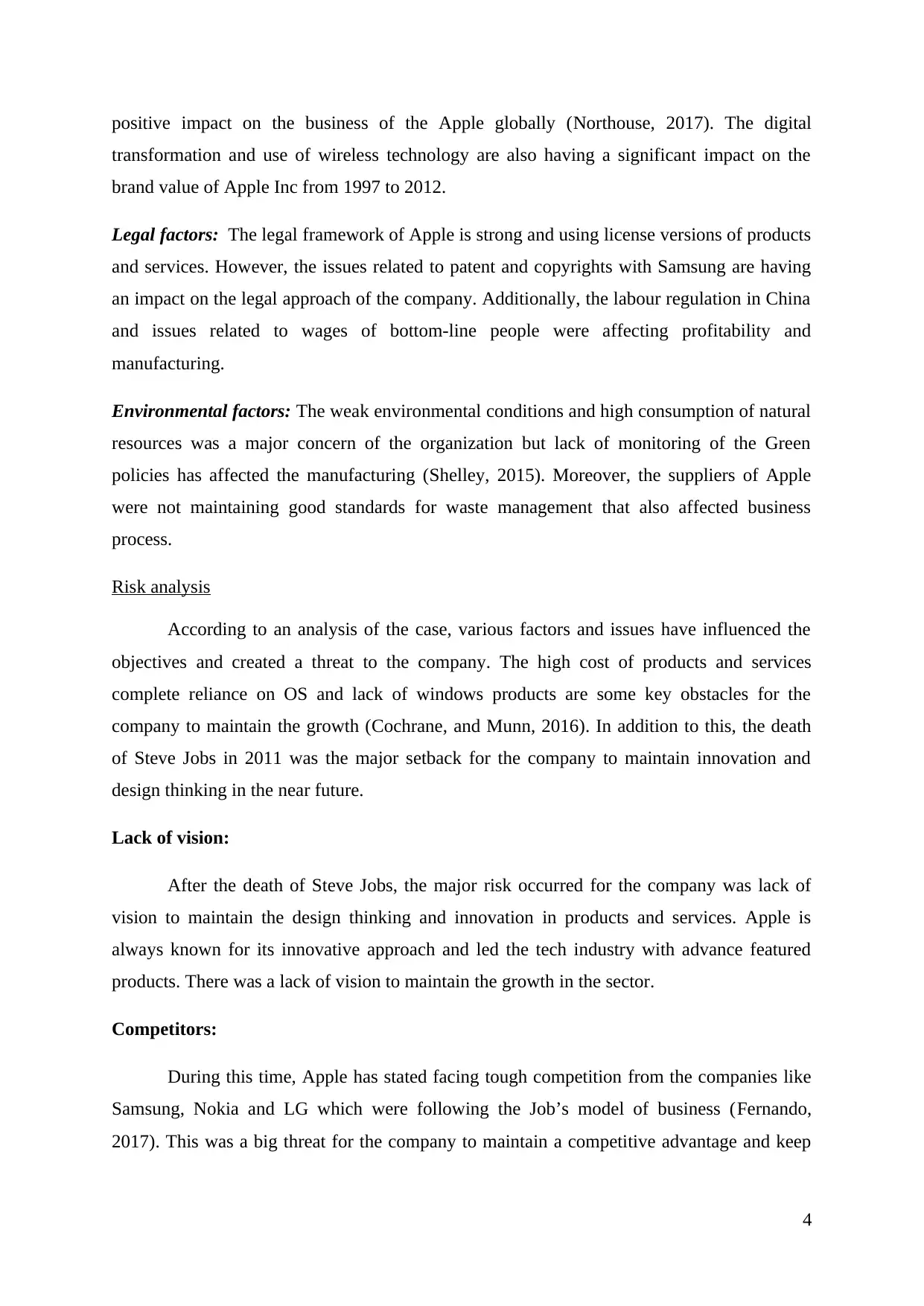
positive impact on the business of the Apple globally (Northouse, 2017). The digital
transformation and use of wireless technology are also having a significant impact on the
brand value of Apple Inc from 1997 to 2012.
Legal factors: The legal framework of Apple is strong and using license versions of products
and services. However, the issues related to patent and copyrights with Samsung are having
an impact on the legal approach of the company. Additionally, the labour regulation in China
and issues related to wages of bottom-line people were affecting profitability and
manufacturing.
Environmental factors: The weak environmental conditions and high consumption of natural
resources was a major concern of the organization but lack of monitoring of the Green
policies has affected the manufacturing (Shelley, 2015). Moreover, the suppliers of Apple
were not maintaining good standards for waste management that also affected business
process.
Risk analysis
According to an analysis of the case, various factors and issues have influenced the
objectives and created a threat to the company. The high cost of products and services
complete reliance on OS and lack of windows products are some key obstacles for the
company to maintain the growth (Cochrane, and Munn, 2016). In addition to this, the death
of Steve Jobs in 2011 was the major setback for the company to maintain innovation and
design thinking in the near future.
Lack of vision:
After the death of Steve Jobs, the major risk occurred for the company was lack of
vision to maintain the design thinking and innovation in products and services. Apple is
always known for its innovative approach and led the tech industry with advance featured
products. There was a lack of vision to maintain the growth in the sector.
Competitors:
During this time, Apple has stated facing tough competition from the companies like
Samsung, Nokia and LG which were following the Job’s model of business (Fernando,
2017). This was a big threat for the company to maintain a competitive advantage and keep
4
transformation and use of wireless technology are also having a significant impact on the
brand value of Apple Inc from 1997 to 2012.
Legal factors: The legal framework of Apple is strong and using license versions of products
and services. However, the issues related to patent and copyrights with Samsung are having
an impact on the legal approach of the company. Additionally, the labour regulation in China
and issues related to wages of bottom-line people were affecting profitability and
manufacturing.
Environmental factors: The weak environmental conditions and high consumption of natural
resources was a major concern of the organization but lack of monitoring of the Green
policies has affected the manufacturing (Shelley, 2015). Moreover, the suppliers of Apple
were not maintaining good standards for waste management that also affected business
process.
Risk analysis
According to an analysis of the case, various factors and issues have influenced the
objectives and created a threat to the company. The high cost of products and services
complete reliance on OS and lack of windows products are some key obstacles for the
company to maintain the growth (Cochrane, and Munn, 2016). In addition to this, the death
of Steve Jobs in 2011 was the major setback for the company to maintain innovation and
design thinking in the near future.
Lack of vision:
After the death of Steve Jobs, the major risk occurred for the company was lack of
vision to maintain the design thinking and innovation in products and services. Apple is
always known for its innovative approach and led the tech industry with advance featured
products. There was a lack of vision to maintain the growth in the sector.
Competitors:
During this time, Apple has stated facing tough competition from the companies like
Samsung, Nokia and LG which were following the Job’s model of business (Fernando,
2017). This was a big threat for the company to maintain a competitive advantage and keep
4
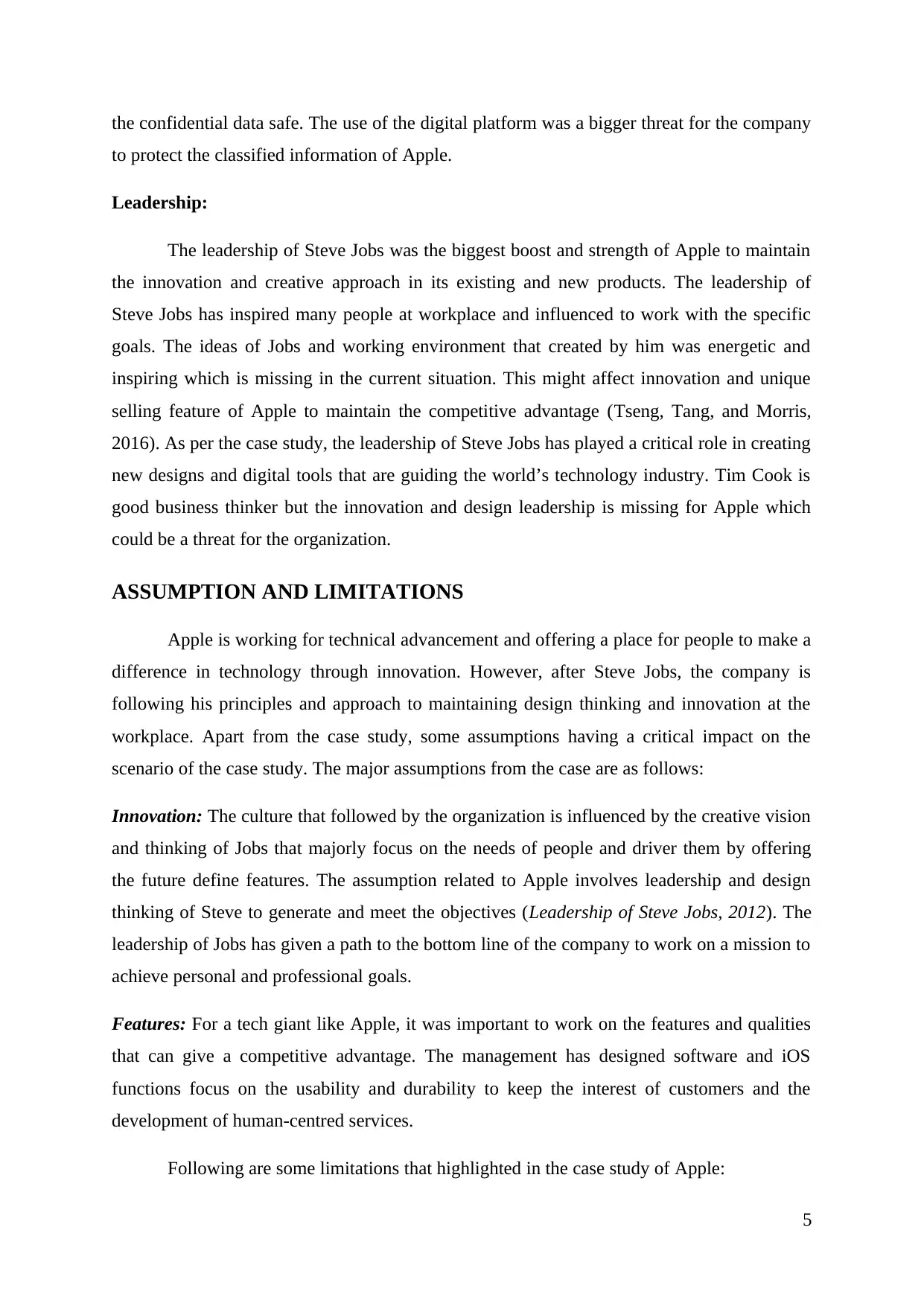
the confidential data safe. The use of the digital platform was a bigger threat for the company
to protect the classified information of Apple.
Leadership:
The leadership of Steve Jobs was the biggest boost and strength of Apple to maintain
the innovation and creative approach in its existing and new products. The leadership of
Steve Jobs has inspired many people at workplace and influenced to work with the specific
goals. The ideas of Jobs and working environment that created by him was energetic and
inspiring which is missing in the current situation. This might affect innovation and unique
selling feature of Apple to maintain the competitive advantage (Tseng, Tang, and Morris,
2016). As per the case study, the leadership of Steve Jobs has played a critical role in creating
new designs and digital tools that are guiding the world’s technology industry. Tim Cook is
good business thinker but the innovation and design leadership is missing for Apple which
could be a threat for the organization.
ASSUMPTION AND LIMITATIONS
Apple is working for technical advancement and offering a place for people to make a
difference in technology through innovation. However, after Steve Jobs, the company is
following his principles and approach to maintaining design thinking and innovation at the
workplace. Apart from the case study, some assumptions having a critical impact on the
scenario of the case study. The major assumptions from the case are as follows:
Innovation: The culture that followed by the organization is influenced by the creative vision
and thinking of Jobs that majorly focus on the needs of people and driver them by offering
the future define features. The assumption related to Apple involves leadership and design
thinking of Steve to generate and meet the objectives (Leadership of Steve Jobs, 2012). The
leadership of Jobs has given a path to the bottom line of the company to work on a mission to
achieve personal and professional goals.
Features: For a tech giant like Apple, it was important to work on the features and qualities
that can give a competitive advantage. The management has designed software and iOS
functions focus on the usability and durability to keep the interest of customers and the
development of human-centred services.
Following are some limitations that highlighted in the case study of Apple:
5
to protect the classified information of Apple.
Leadership:
The leadership of Steve Jobs was the biggest boost and strength of Apple to maintain
the innovation and creative approach in its existing and new products. The leadership of
Steve Jobs has inspired many people at workplace and influenced to work with the specific
goals. The ideas of Jobs and working environment that created by him was energetic and
inspiring which is missing in the current situation. This might affect innovation and unique
selling feature of Apple to maintain the competitive advantage (Tseng, Tang, and Morris,
2016). As per the case study, the leadership of Steve Jobs has played a critical role in creating
new designs and digital tools that are guiding the world’s technology industry. Tim Cook is
good business thinker but the innovation and design leadership is missing for Apple which
could be a threat for the organization.
ASSUMPTION AND LIMITATIONS
Apple is working for technical advancement and offering a place for people to make a
difference in technology through innovation. However, after Steve Jobs, the company is
following his principles and approach to maintaining design thinking and innovation at the
workplace. Apart from the case study, some assumptions having a critical impact on the
scenario of the case study. The major assumptions from the case are as follows:
Innovation: The culture that followed by the organization is influenced by the creative vision
and thinking of Jobs that majorly focus on the needs of people and driver them by offering
the future define features. The assumption related to Apple involves leadership and design
thinking of Steve to generate and meet the objectives (Leadership of Steve Jobs, 2012). The
leadership of Jobs has given a path to the bottom line of the company to work on a mission to
achieve personal and professional goals.
Features: For a tech giant like Apple, it was important to work on the features and qualities
that can give a competitive advantage. The management has designed software and iOS
functions focus on the usability and durability to keep the interest of customers and the
development of human-centred services.
Following are some limitations that highlighted in the case study of Apple:
5
⊘ This is a preview!⊘
Do you want full access?
Subscribe today to unlock all pages.

Trusted by 1+ million students worldwide
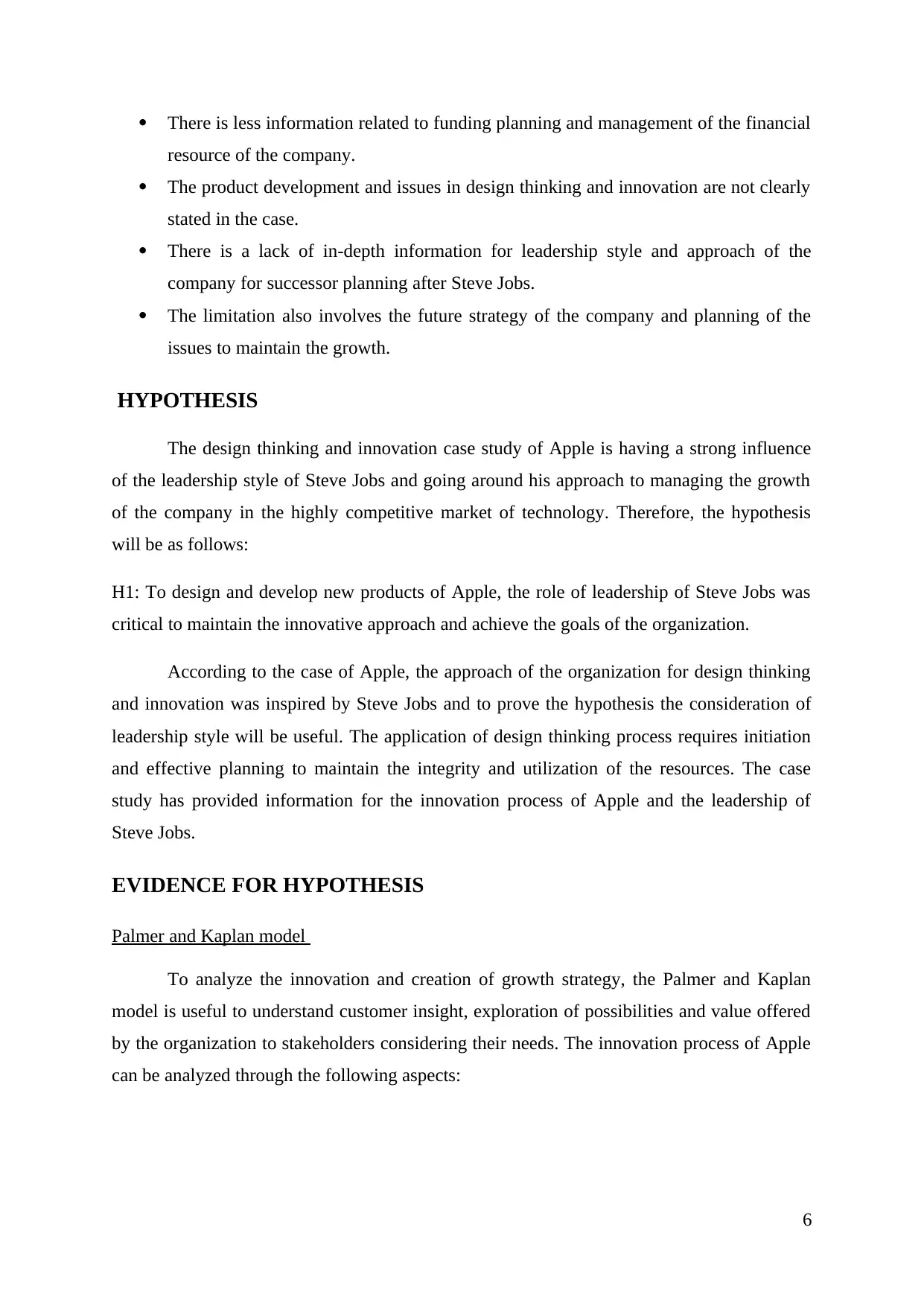
There is less information related to funding planning and management of the financial
resource of the company.
The product development and issues in design thinking and innovation are not clearly
stated in the case.
There is a lack of in-depth information for leadership style and approach of the
company for successor planning after Steve Jobs.
The limitation also involves the future strategy of the company and planning of the
issues to maintain the growth.
HYPOTHESIS
The design thinking and innovation case study of Apple is having a strong influence
of the leadership style of Steve Jobs and going around his approach to managing the growth
of the company in the highly competitive market of technology. Therefore, the hypothesis
will be as follows:
H1: To design and develop new products of Apple, the role of leadership of Steve Jobs was
critical to maintain the innovative approach and achieve the goals of the organization.
According to the case of Apple, the approach of the organization for design thinking
and innovation was inspired by Steve Jobs and to prove the hypothesis the consideration of
leadership style will be useful. The application of design thinking process requires initiation
and effective planning to maintain the integrity and utilization of the resources. The case
study has provided information for the innovation process of Apple and the leadership of
Steve Jobs.
EVIDENCE FOR HYPOTHESIS
Palmer and Kaplan model
To analyze the innovation and creation of growth strategy, the Palmer and Kaplan
model is useful to understand customer insight, exploration of possibilities and value offered
by the organization to stakeholders considering their needs. The innovation process of Apple
can be analyzed through the following aspects:
6
resource of the company.
The product development and issues in design thinking and innovation are not clearly
stated in the case.
There is a lack of in-depth information for leadership style and approach of the
company for successor planning after Steve Jobs.
The limitation also involves the future strategy of the company and planning of the
issues to maintain the growth.
HYPOTHESIS
The design thinking and innovation case study of Apple is having a strong influence
of the leadership style of Steve Jobs and going around his approach to managing the growth
of the company in the highly competitive market of technology. Therefore, the hypothesis
will be as follows:
H1: To design and develop new products of Apple, the role of leadership of Steve Jobs was
critical to maintain the innovative approach and achieve the goals of the organization.
According to the case of Apple, the approach of the organization for design thinking
and innovation was inspired by Steve Jobs and to prove the hypothesis the consideration of
leadership style will be useful. The application of design thinking process requires initiation
and effective planning to maintain the integrity and utilization of the resources. The case
study has provided information for the innovation process of Apple and the leadership of
Steve Jobs.
EVIDENCE FOR HYPOTHESIS
Palmer and Kaplan model
To analyze the innovation and creation of growth strategy, the Palmer and Kaplan
model is useful to understand customer insight, exploration of possibilities and value offered
by the organization to stakeholders considering their needs. The innovation process of Apple
can be analyzed through the following aspects:
6
Paraphrase This Document
Need a fresh take? Get an instant paraphrase of this document with our AI Paraphraser
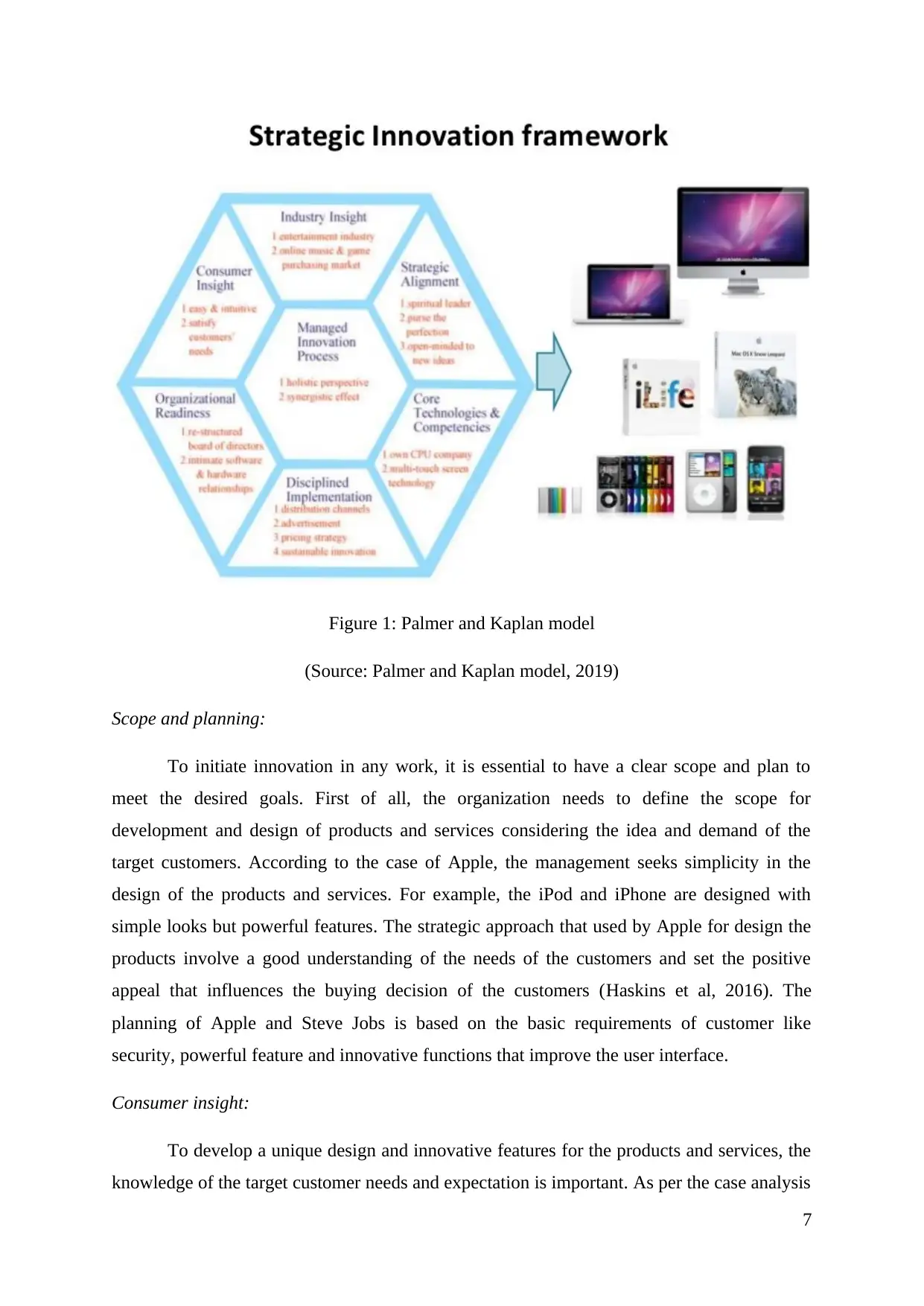
Figure 1: Palmer and Kaplan model
(Source: Palmer and Kaplan model, 2019)
Scope and planning:
To initiate innovation in any work, it is essential to have a clear scope and plan to
meet the desired goals. First of all, the organization needs to define the scope for
development and design of products and services considering the idea and demand of the
target customers. According to the case of Apple, the management seeks simplicity in the
design of the products and services. For example, the iPod and iPhone are designed with
simple looks but powerful features. The strategic approach that used by Apple for design the
products involve a good understanding of the needs of the customers and set the positive
appeal that influences the buying decision of the customers (Haskins et al, 2016). The
planning of Apple and Steve Jobs is based on the basic requirements of customer like
security, powerful feature and innovative functions that improve the user interface.
Consumer insight:
To develop a unique design and innovative features for the products and services, the
knowledge of the target customer needs and expectation is important. As per the case analysis
7
(Source: Palmer and Kaplan model, 2019)
Scope and planning:
To initiate innovation in any work, it is essential to have a clear scope and plan to
meet the desired goals. First of all, the organization needs to define the scope for
development and design of products and services considering the idea and demand of the
target customers. According to the case of Apple, the management seeks simplicity in the
design of the products and services. For example, the iPod and iPhone are designed with
simple looks but powerful features. The strategic approach that used by Apple for design the
products involve a good understanding of the needs of the customers and set the positive
appeal that influences the buying decision of the customers (Haskins et al, 2016). The
planning of Apple and Steve Jobs is based on the basic requirements of customer like
security, powerful feature and innovative functions that improve the user interface.
Consumer insight:
To develop a unique design and innovative features for the products and services, the
knowledge of the target customer needs and expectation is important. As per the case analysis
7
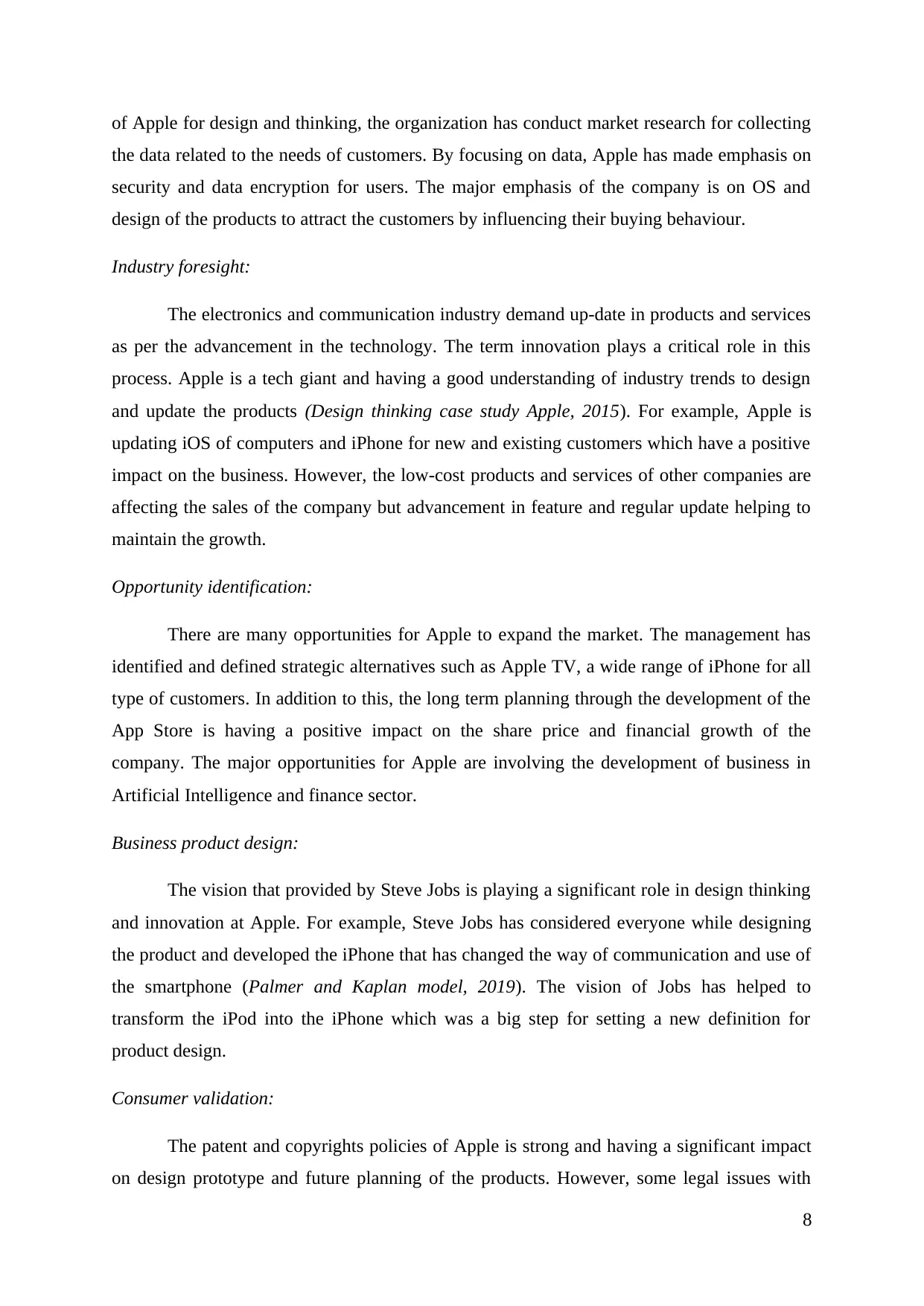
of Apple for design and thinking, the organization has conduct market research for collecting
the data related to the needs of customers. By focusing on data, Apple has made emphasis on
security and data encryption for users. The major emphasis of the company is on OS and
design of the products to attract the customers by influencing their buying behaviour.
Industry foresight:
The electronics and communication industry demand up-date in products and services
as per the advancement in the technology. The term innovation plays a critical role in this
process. Apple is a tech giant and having a good understanding of industry trends to design
and update the products (Design thinking case study Apple, 2015). For example, Apple is
updating iOS of computers and iPhone for new and existing customers which have a positive
impact on the business. However, the low-cost products and services of other companies are
affecting the sales of the company but advancement in feature and regular update helping to
maintain the growth.
Opportunity identification:
There are many opportunities for Apple to expand the market. The management has
identified and defined strategic alternatives such as Apple TV, a wide range of iPhone for all
type of customers. In addition to this, the long term planning through the development of the
App Store is having a positive impact on the share price and financial growth of the
company. The major opportunities for Apple are involving the development of business in
Artificial Intelligence and finance sector.
Business product design:
The vision that provided by Steve Jobs is playing a significant role in design thinking
and innovation at Apple. For example, Steve Jobs has considered everyone while designing
the product and developed the iPhone that has changed the way of communication and use of
the smartphone (Palmer and Kaplan model, 2019). The vision of Jobs has helped to
transform the iPod into the iPhone which was a big step for setting a new definition for
product design.
Consumer validation:
The patent and copyrights policies of Apple is strong and having a significant impact
on design prototype and future planning of the products. However, some legal issues with
8
the data related to the needs of customers. By focusing on data, Apple has made emphasis on
security and data encryption for users. The major emphasis of the company is on OS and
design of the products to attract the customers by influencing their buying behaviour.
Industry foresight:
The electronics and communication industry demand up-date in products and services
as per the advancement in the technology. The term innovation plays a critical role in this
process. Apple is a tech giant and having a good understanding of industry trends to design
and update the products (Design thinking case study Apple, 2015). For example, Apple is
updating iOS of computers and iPhone for new and existing customers which have a positive
impact on the business. However, the low-cost products and services of other companies are
affecting the sales of the company but advancement in feature and regular update helping to
maintain the growth.
Opportunity identification:
There are many opportunities for Apple to expand the market. The management has
identified and defined strategic alternatives such as Apple TV, a wide range of iPhone for all
type of customers. In addition to this, the long term planning through the development of the
App Store is having a positive impact on the share price and financial growth of the
company. The major opportunities for Apple are involving the development of business in
Artificial Intelligence and finance sector.
Business product design:
The vision that provided by Steve Jobs is playing a significant role in design thinking
and innovation at Apple. For example, Steve Jobs has considered everyone while designing
the product and developed the iPhone that has changed the way of communication and use of
the smartphone (Palmer and Kaplan model, 2019). The vision of Jobs has helped to
transform the iPod into the iPhone which was a big step for setting a new definition for
product design.
Consumer validation:
The patent and copyrights policies of Apple is strong and having a significant impact
on design prototype and future planning of the products. However, some legal issues with
8
⊘ This is a preview!⊘
Do you want full access?
Subscribe today to unlock all pages.

Trusted by 1+ million students worldwide
1 out of 19
Related Documents
Your All-in-One AI-Powered Toolkit for Academic Success.
+13062052269
info@desklib.com
Available 24*7 on WhatsApp / Email
![[object Object]](/_next/static/media/star-bottom.7253800d.svg)
Unlock your academic potential
Copyright © 2020–2025 A2Z Services. All Rights Reserved. Developed and managed by ZUCOL.





